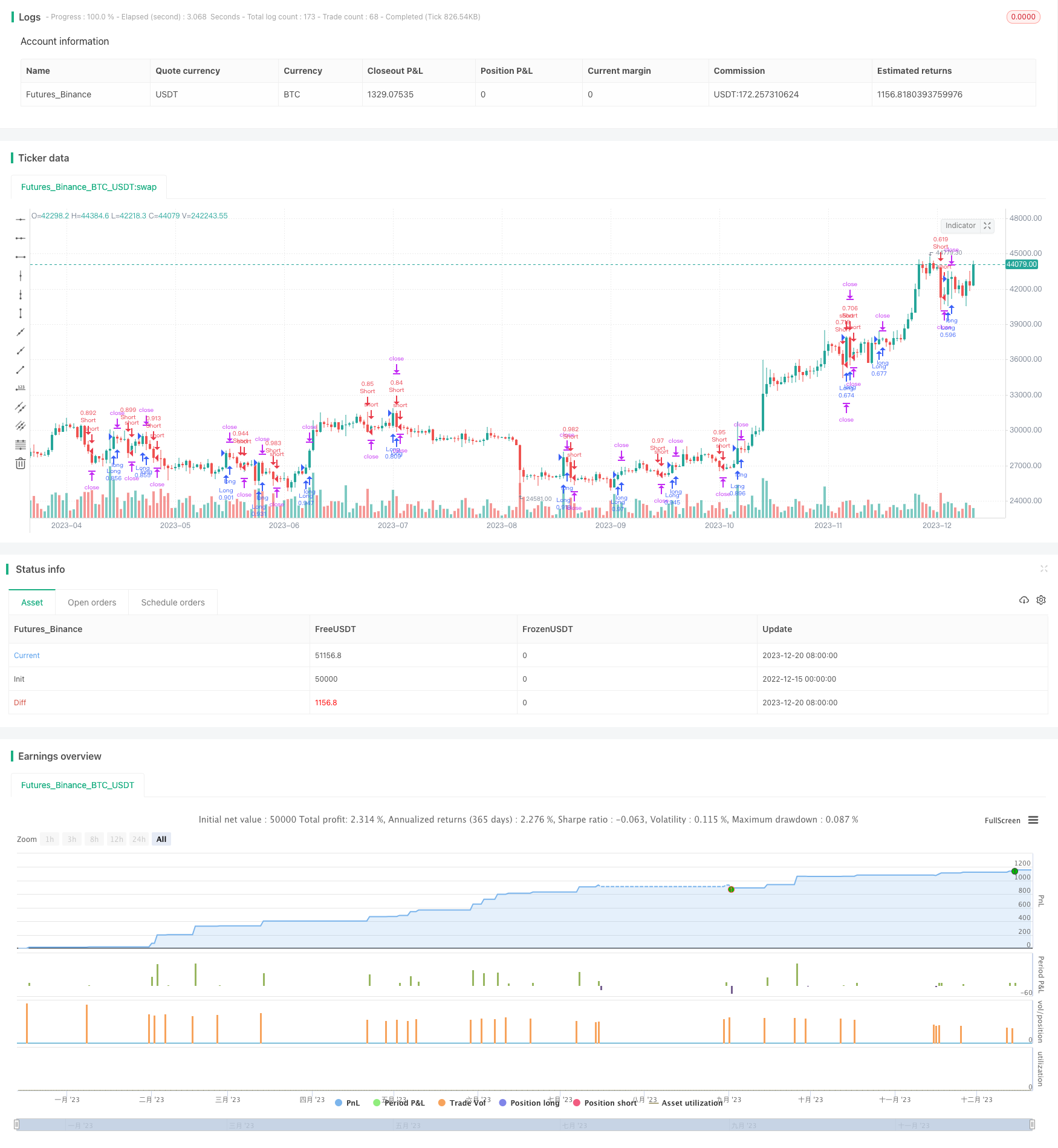
概述
该策略是一个基于量化模型定制的高效量化交易策略。策略使用了Modelius Volume模型作为基础模型,并在此基础上进行了扩展和优化。该策略可以捕捉市场中的量化交易机会,实现稳定的盈利。
策略原理
该策略的核心是Modelius Volume模型。该模型利用价格、交易量的变化来识别市场中的量化交易机会。具体来说,策略结合使用了close价格、open价格、最高价、最低价,根据一定的规则计算出当前K线的方向。当K线方向发生变化时,根据交易量的大小来判断量化交易机会的质量。此外,策略还结合了SAR指标和均线指标来辅助判断入场和出场时机。
基本交易逻辑是,当指标从负值向正值突破时,做多;当指标从正值向负值突破时,做空。此外,策略还设置了止损、止盈、跟踪止损来控制风险。
优势分析
该策略最大的优势在于利用Modelius Volume模型能够有效识别量化交易机会。与传统技术指标相比,该模型更加关注交易量的变化,这在目前的高频量化交易中非常实用。此外,策略的入场规则比较严格,可以有效避免错过量化交易机会的同时也能尽量减少乱序的概率。
风险分析
该策略主要的风险在于Modelius Volume模型本身并不能完全避免噪音。当市场出现异常波动时,会导致交易信号产生错误。此外,策略中的参数设置也会对最终结果产生影响。
为了控制风险,可适当调整参数,并结合其他指标进行辅助判断。此外也需要合理设置止损、止盈位置。
优化方向
该策略还有一定的优化空间。例如可以考虑结合机器学习算法来动态优化参数设置。或者结合情绪分析等指标来提高决策的准确性。此外也可以研究不同品种之间的相关性,建立多品种套利模型。
总结
总的来说,该策略利用Modelius Volume量化模型的优势,设计了一套可操作性较强的量化交易策略。可通过参数调整、模型扩展、机器学习等方式进行优化提升,在实际交易中获得较好的稳定收益。
/*backtest
start: 2022-12-15 00:00:00
end: 2023-12-21 00:00:00
period: 1d
basePeriod: 1h
exchanges: [{"eid":"Futures_Binance","currency":"BTC_USDT"}]
*/
//@version=3
strategy(title="strategy modelius volume model ", shorttitle="mvm",overlay=true, calc_on_order_fills=true, default_qty_type=strategy.percent_of_equity, default_qty_value=50, overlay=false)
method = input(defval="ATR", options=["ATR", "Traditional", "Part of Price"], title="Renko Assignment Method")
methodvalue = input(defval=14.0, type=float, minval=0, title="Value")
pricesource = input(defval="Close", options=["Close", "Open / Close", "High / Low"], title="Price Source")
useClose = pricesource == "Close"
useOpenClose = pricesource == "Open / Close" or useClose
useTrueRange = input(defval="Auto", options=["Always", "Auto", "Never"], title="Use True Range instead of Volume")
isOscillating=input(defval=true, type=bool, title="Oscillating")
normalize=input(defval=false, type=bool, title="Normalize")
vol = useTrueRange == "Always" or (useTrueRange == "Auto" and na(volume))? tr : volume
op = useClose ? close : open
hi = useOpenClose ? close >= op ? close : op : high
lo = useOpenClose ? close <= op ? close : op : low
if method == "ATR"
methodvalue := atr(round(methodvalue))
if method == "Part of Price"
methodvalue := close/methodvalue
currclose = na
prevclose = nz(currclose[1])
prevhigh = prevclose + methodvalue
prevlow = prevclose - methodvalue
currclose := hi > prevhigh ? hi : lo < prevlow ? lo : prevclose
direction = na
direction := currclose > prevclose ? 1 : currclose < prevclose ? -1 : nz(direction[1])
directionHasChanged = change(direction) != 0
directionIsUp = direction > 0
directionIsDown = direction < 0
barcount = 1
barcount := not directionHasChanged and normalize ? barcount[1] + barcount : barcount
vol := not directionHasChanged ? vol[1] + vol : vol
res = barcount > 1 ? vol/barcount : vol
x=isOscillating and directionIsDown ? -res : res
TP = input(0) * 10
SL = input(0) * 10
TS = input(1) * 10
TO = input(3) * 10
CQ = 100
TPP = (TP > 0) ? TP : na
SLP = (SL > 0) ? SL : na
TSP = (TS > 0) ? TS : na
TOP = (TO > 0) ? TO : na
longCondition = crossover(x,0)
if (longCondition)
strategy.entry("Long", strategy.long)
shortCondition = crossunder(x,0)
if (shortCondition)
strategy.entry("Short", strategy.short)
strategy.exit("Close Short", "Short", qty_percent=CQ, profit=TPP, loss=SLP, trail_points=TSP, trail_offset=TOP)
strategy.exit("Close Long", "Long", qty_percent=CQ, profit=TPP, loss=SLP, trail_points=TSP, trail_offset=TOP)